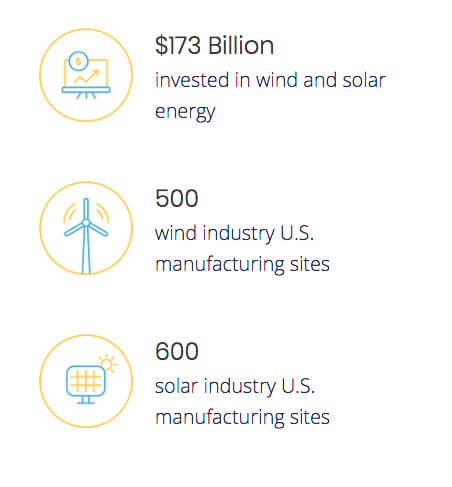The Wind Solar Alliance (WSA), formerly known as the Wind Energy Foundation, has a new name, reflecting an increased focus on rapidly deploying wind and solar energy to deliver the maximum economic and environmental benefits.

WSA aims to focus on research, communication, and advocacy to raise awareness of the benefits of both wind and solar power.
WSA has also expanded its board of directors to include experts on solar energy, including most recently adding two executives from leading U.S. solar companies, NEXTracker and First Solar. Having led national wind-solar advocacy campaigns for several years through its “A Renewable America” program, WSA saw an opportunity for increased collaboration between the two sectors, compelling the re-brand.
“Accelerating the deployment of wind and solar technologies is one of the fastest ways to mitigate climate change while strengthening the U.S. economy,” said John Kostyack, Executive Director of WSA. “The new name reflects our view that wind and solar industry leaders and other energy experts are stronger working together on this shared agenda than apart. Our coalition effort is now well-positioned to reform the U.S. electricity markets, as well as transmission and utility procurement planning processes, and thereby to rapidly scale these two technologies.”
Dan Shugar, NEXTracker founder and CEO, and Colin Meehan, First Solar’s Director of Regulatory and Public Affairs, join leaders from other solar-only, wind-solar, and wind-only companies on the WSA board. The American Wind Energy Association’s (AWEA) CEO, Tom Kiernan, also sits on the WSA board. Mark Alhstrom, President of the Energy Systems Integration Group and one of the nation’s leading experts on integrating renewable energy onto the electricity grid, serves as a board advisor.
WSA will continue to focus on research, communication, and advocacy to raise awareness of the benefits of renewable energy. In addition, the organization will give increased attention to addressing the need for policy changes in the Independent System Operators, Public Utility Commissions, and other venues that determine whether renewables will be given a fair opportunity to compete in the electricity marketplace.
Since 2014, WSA’s “A Renewable America” campaign has spurred collaboration with the two leading wind and solar energy trade associations, AWEA and SEIA, and their members on research, communications, and policy advocacy. Since its inception, the campaign has worked in support of key federal and state policy initiatives, such as the 2015 extensions of the federal Production and Investment Tax Credits, the EPA’s Clean Power Plan, and the 2016 update of Illinois’ renewable portfolio standard.
“WSA’s Executive Director, John Kostyack, has done a great job in keeping ahead of an important trend toward increased coordination of wind and solar advocacy,” said Tom Kiernan, CEO of AWEA. “The organization’s expanded vision will continue to complement AWEA’s education and advocacy efforts.”
WSA’s education and advocacy campaigns (the Grid Campaign, the Renewable Energy Jobs Tour, and Electric Nation: Powered by Wind) are supported with funds from major foundations, AWEA and SEIA, and leading wind and solar companies. The campaigns mobilize leaders from the wind and solar industries and other experts to deliver facts, data, and personalized messages to decision makers about how renewable energy is helping to improve our economy and environment.
“This new partnership has the opportunity to unite strong and effective energy leaders and create an unstoppable team delivering on the benefits of a clean energy economy,” said Eric Heitz, CEO and Co-founder of Energy Foundation. “We recognize that much more work is needed, and it is needed now, if we are to successfully confront the worst impacts of climate change. Wind and solar energy promise a healthier environment and more sustainable economy for everyone. We are proud to support this work.”
Wind and solar power comprised about 50 percent of all new U.S. electric capacity additions in 2017, representing over $25 billion in new investment. Wind and solar powered roughly 8 percent of the total U.S. electricity consumption in the last year. However, a recent estimate suggested that the two industries would need to combine to add an average of nearly 40 gigawatts of new capacity each year through 2050 for the U.S. to uphold its international climate goals – more than twice the best year of deployment of wind and solar installations to date.
Filed Under: News, Policy




